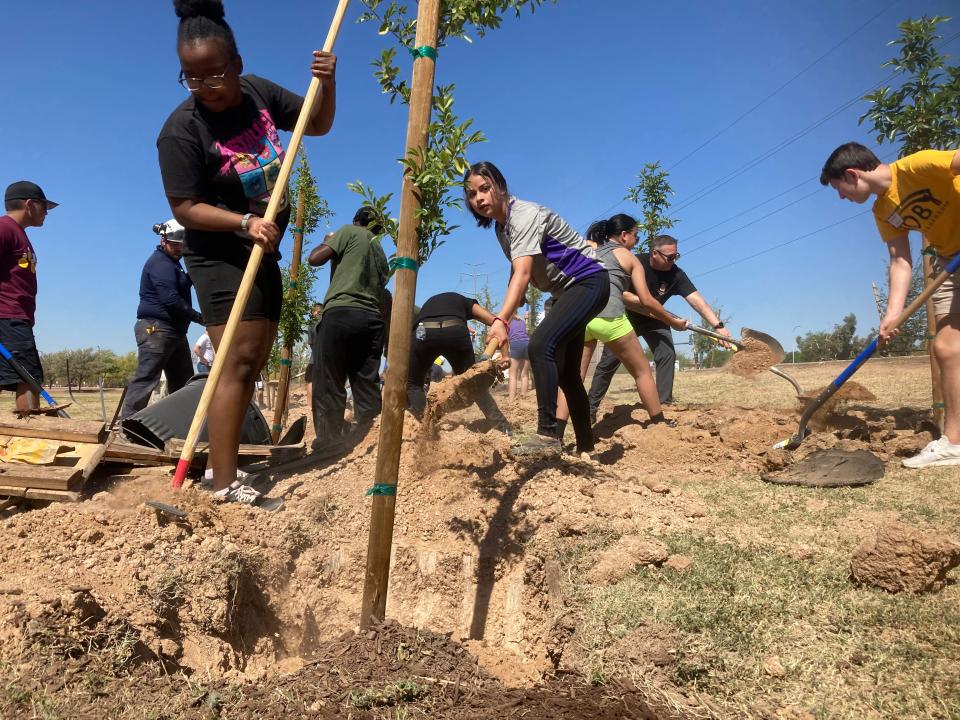Poor neighborhoods suffer most from Phoenix's brutal heat. It doesn't have to be this way
Communities that are poor and/or home to BIPOC (Black, Indigenous and other people of color) families face elevated risks from climate change and the severe weather that can accompany it.
These same communities generally have less access to greenspace than more privileged neighborhoods – even within the same cities.
This is a dangerous combination.
Trees are an essential component of “green infrastructure,” a stormwater management system that uses curb cuts, downspouts and swales to direct runoff to basins that contain plants, soil and permeable material allowing the infiltration of stormwater into the aquifers.
This type of system controls pollutants, recycles water and reduces the danger of flooding. It promotes resilience on many levels, from personal health to the ability of buildings to cope with extreme weather.
Poor neighborhoods have fewer trees
A 2021 analysis found that low-income blocks in most urban communities in the U.S. had 62 million fewer trees than comparable high-income blocks. The same research showed that blocks housing people of color had less tree cover. In both cases, less tree cover was associated with higher summer temperatures.
Heat coming: New climate report highlights risks for metro areas
In cities located in the southwestern U.S., intensive heat and water scarcity are exacerbating the need to invest in resilience efforts. Water scarcity in this region has reached unprecedented levels – now referred to as “megadrought” – according to my colleagues who study water policy in this region.
The Colorado River, which supports seven U.S. states and communities in northern Mexico, is showing the lowest levels of water in history. Now more than ever, we need to consider stormwater, reclaimed water and rainwater as a resource to irrigate greenspace and enhance our quality of life in cities.
Why these areas lack green infrastructure

Work I and other researchers have done shows that green infrastructure projects can succeed in neighborhoods that are too often passed over for these opportunities.
All stakeholders should be at the table to plan, design, implement and maintain green infrastructure projects. This is hardly a given in communities where people work multiple jobs, have poor access to transportation and have little or no leisure time.
For a process to be truly accessible, governments and nonprofits need to ask themselves a series of questions.
Can you take a bus to the meeting site?
Will there be child care provided?
Can you still earn your salary if you attend the meeting? And much more.
Having inclusive processes is critical for policymaking because there are multiple justice issues to consider.
Tucson's policy helped some, excluded others
For example, Tucson maintains a rebate program for residential water customers that aims to promote the adoption of rainwater harvesting practices.
When the city mapped where the rebates were distributed, they found that higher income neighborhoods benefited most. A nonprofit stepped in to offer loans, and later, grants to lower income homeowners so that they could apply for the rebate and make rainwater harvesting improvements to their properties.
That was a solid step forward, but renters were indirectly excluded from the program – and many of these renters live in apartment buildings with no yard to install the system, often within “urban heat islands,” where the temperature is noticeably hotter than the rest of the city.
Policies like this one should be evaluated with an equity lens continuously.
Don't just plant a tree. Plan to keep it alive
Green infrastructure projects fail to benefit lower-income neighborhoods for other reasons as well, such as neglecting to incorporate greenspaces within walkable neighborhoods. For people without cars, walkability is access.
Our research has shown that people who live in walkable neighborhoods that are near a park are likely to visit that park more frequently and enjoy their wellbeing benefits.
Finally, green infrastructure investments must include funding to maintain the community asset long after the ribbon cutting. It is incredibly common to plant trees without any plan to keep them alive. Again, this is a much bigger problem for low-resource communities and contributes to their green infrastructure deficit.
We worked with a school in Tucson, where the principal was personally responsible for watering trees. In an affluent district, watering – not to mention trimming and fertilizing – a tree could be absorbed by a grounds crew. Our engagement with this school was precisely to provide a green irrigation system and eliminate the watering from the principal’s weekend schedule.
This is about our mutual survival
In 2019, France’s National Assembly adopted a Declaration of Tree Rights, which reads in part: “A tree is a living organism whose average lifespan is far longer than that of a human being. It should be respected throughout its life and have the right to develop and to reproduce freely, from its birth to its natural death, whether it be a town tree or a country tree.”
It may seem extraordinary to place the rights of trees on par with the rights of humans, but those rights support each other. In the communities where humans face the most danger from climate change, trees are also endangered.
To build human resilience in our urban areas we should ensure that green infrastructure is accessible to everyone, and that it is maintained and protected so that it can continue its invaluable service to people in the long term.
Adriana A. Zuniga-Teran, Ph.D. is an assistant professor at the School of Geography, Development & Environment and the Udall Center for Studies in Public Policy, at the University of Arizona. Reach her at aazuniga@arizona.edu.
This article originally appeared on Arizona Republic: Why heat, water scarcity hurt poor neighborhoods most

